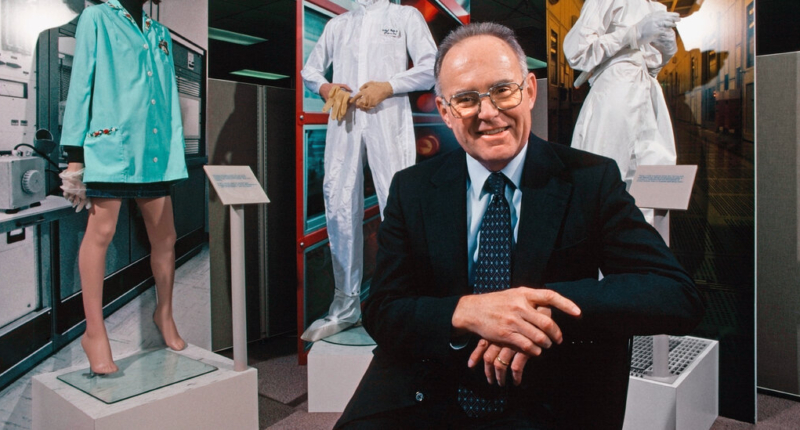Gordon E. Moore, the founder of Intel, died at the age of 92. Moore was known for his contributions to the invention of the microprocessor and the establishment of the renowned Moore’s Law. In the mid-1980s, Intel, with its silicon microprocessors, regained the lead in the vast computer data-processing field from their formidable Japanese competitors. By the ’90s, Intel had placed its microprocessors in 80 percent of the computers that were being made worldwide. In 2001, Moore and his wife created the Gordon and Betty Moore Foundation with a donation of 175 million Intel shares. They also donated $600 million to the California Institute of Technology, the largest single gift to an institution of higher learning at the time. Moore’s survivors include his wife, two sons, and four grandchildren. Moore’s legacy is his eponymous law, which accurately predicted the increase in microprocessor power over time, leading to the exponential growth of the technology industry. Moore’s Law is bound to reach its end, as engineers encounter some basic physical limits, and the pace of miniaturization has slowed.
Gordon E. Moore, Co-Founder of Intel and Father of Moore’s Law, Passes Away at 94
Gordon E. Moore, a co-founder of Intel Corporation, passed away at his home in Hawaii at the age of 94. Together with Robert Noyce, Moore co-founded Intel, the semiconductor chip maker that played a significant role in the development of Silicon Valley. Moore’s Law, a prediction he made in the 1960s about the exponential growth of computer chip technology, is one of his most notable contributions to the tech industry.
Moore’s death was announced by Intel and the Gordon and Betty Moore Foundation, but no cause was given. He is survived by his wife, Betty Irene Whitaker, and three sons.
Moore, who had originally intended to become a teacher, became an “accidental entrepreneur” after investing $500 in the microchip business, which went on to become one of the world’s largest industries.
Moore’s prediction about the number of transistors that could be placed on a silicon chip doubling at regular intervals, thus increasing the data-processing power of computers exponentially, became known as Moore’s Law. He later added two corollaries: the evolving technology would make computers more and more expensive to build, yet consumers would be charged less and less for them because so many would be sold. Moore’s Law held up for decades and paved the way for the development of laptops, microprocessors, and countless other electronic devices.
Thanks to Moore’s brilliance, leadership, charisma, and connections, as well as that of his partner Robert Noyce, Intel was able to assemble a group of highly creative technicians. They were the ones who championed the use of silicon chips, which allowed for the creation of smaller and faster electronic circuitry.
Today, Moore’s Law is reaching its limits, but its impact on the tech industry will be felt for generations to come.
Gordon E. Moore, Co-Founder of Intel and Father of Moore’s Law, Leaves a Legacy of Technical Innovation and Philanthropy
Gordon E. Moore, the co-founder of Intel Corporation, passed away at the age of 94. During his tenure as chief executive of Intel from 1975 to 1987, the company revolutionized the computer industry with its silicon microprocessors, which enabled American manufacturers to regain the lead in the computer data-processing field from their Japanese competitors in the mid-1980s. By the 1990s, Intel’s microprocessors were used in 80% of the computers made worldwide, making it the most successful semiconductor company in history.
Moore’s Law, which predicted that the number of transistors on a silicon chip would double at regular intervals, became his most notable contribution to the tech industry. This prediction allowed for the exponential growth of computer chip technology, making computers smaller, faster, and more affordable for consumers. Technology firms based their product strategies on the assumption that Moore’s Law would hold, as it did for decades.
Moore’s success enabled him to become a major philanthropist. In 2001, he and his wife created the Gordon and Betty Moore Foundation with a donation of 175 million Intel shares. The foundation has since grown to more than $8 billion in assets and has given away more than $5 billion since its founding. In 2001, the Moores donated $600 million to the California Institute of Technology, the largest single gift to an institution of higher learning at the time.
Despite his technical and philanthropic achievements, Moore remained humble about his accomplishments. He believed that semiconductor devices were the key to making electronics more affordable and accessible, and he dedicated his life’s work to that end. Moore’s Law became a critical foundation for the technology industry, shaping it into what it is today.
Born in San Francisco in 1929, Moore grew up in Pescadero, a small coastal town south of San Francisco. He enrolled at San Jose State College and completed his undergraduate studies at the University of California, Berkeley, with a degree in chemistry. In 1954, he received his doctorate, also in chemistry, from Caltech.
Moore’s legacy will live on as one of the most influential figures in the tech industry. His technical innovations, coupled with his philanthropic efforts, have left an indelible mark on the world.
Gordon E. Moore: Co-Founder of Intel and Father of Moore’s Law
Gordon E. Moore, the co-founder of Intel Corporation, played a significant role in revolutionizing the computer industry. His technical innovations and philanthropic efforts left a mark on the world that will never be forgotten.
Moore had an illustrious career that spanned decades. He began his career as a chemist, receiving his undergraduate degree from the University of California, Berkeley, and his doctorate from Caltech. He went on to work for a variety of organizations, including Dow Chemical, the Applied Physics Laboratory at Johns Hopkins University, and Bell Laboratories. In 1957, Moore and Robert Noyce left Shockley Semiconductor to form Fairchild Semiconductor. Afterward, they founded Intel in 1968, where Moore served as chief executive from 1975 to 1987, when Andrew Grove succeeded him, and remained chairman until 1997.
Under Moore’s leadership, Intel created silicon microprocessors, which allowed American manufacturers to regain the lead in the computer data-processing field from their Japanese competitors in the mid-1980s. By the 1990s, Intel’s microprocessors were used in 80% of the computers made worldwide, making it the most successful semiconductor company in history.
Moore’s most significant contribution to the tech industry was his prediction in 1965 that the number of transistors on a silicon chip would double at regular intervals, an idea that became known as Moore’s Law. The exponential growth of computer chip technology made computers smaller, faster, and more affordable for consumers. Technology firms based their product strategies on the assumption that Moore’s Law would hold, which it did for decades.
Moore was not only a tech industry giant but also a major philanthropist. In 2001, he and his wife created the Gordon and Betty Moore Foundation with a donation of 175 million Intel shares. The foundation has since grown to more than $8 billion in assets and has given away more than $5 billion since its founding. In 2001, the Moores donated $600 million to the California Institute of Technology, the largest single gift to an institution of higher learning at the time.
Although Moore’s achievements were impressive, he remained humble. He believed that semiconductor devices were the key to making electronics more affordable and accessible, and he dedicated his life’s work to that end. Moore’s Law became a critical foundation for the technology industry, shaping it into what it is today.
One of the most significant events in Moore’s life was his decision to co-found Intel. In 1968, he and Noyce founded Integrated Electronics Corporation, which they later shortened to Intel. Intel began with a vague business plan but had no trouble finding financial backing, with $2.5 million in capital. The third employee was Andrew Grove, a young Hungarian immigrant who had worked under Moore at Fairchild.
Intel hit its stride in the early 1970s with the release of the 4000 series “computer on a chip.” This innovation started the revolution in personal computers. However, Intel itself missed the opportunity to manufacture a personal computer, partly because of Moore’s shortsightedness.
Moore passed away in Hawaii at the age of 94. His technical innovations, coupled with his philanthropic efforts, left an indelible mark on the world. He will always be remembered as a tech industry pioneer and the father of Moore’s Law.
Gordon Moore, who co-founded Intel and made a significant contribution to the world of semiconductors and microprocessors, passed away at the age of 92. His innovations have been used in countless personal computers and electronic devices worldwide. He was a modest and unassuming person who preferred tattered shirts and khakis to tailored suits.
Moore’s early career started with his co-invention of the transistor, and he later contributed a chapter to a book that described what would become known as Moore’s Law. Two years later, he published an article in Electronics magazine, which led to the explicit numerical prediction of Moore’s Law. His prediction proved to be reliable, and technology companies based their product strategy on the assumption that the law would hold.
In 1956, Mr. Moore joined William Shockley, a co-inventor of the transistor, to work at a West Coast division of Bell Laboratories. In 1957, Mr. Moore and Mr. Noyce joined a group of defectors who came to be known as “the traitorous eight” and founded the Fairchild Semiconductor Corporation. Later, they formed their company, Intel, focusing on semiconductor memory.
Moore’s Law is bound to reach its end, as engineers encounter some basic physical limits, as well as the extreme cost of building factories to achieve the next level of miniaturization. And in recent years, the pace of miniaturization has slowed.
Moore and his wife, Betty, created the Gordon and Betty Moore Foundation in 2001, which currently has assets exceeding $8 billion and has given away more than $5 billion since its founding.
Mr. Moore is survived by his wife, two sons, Kenneth and Steven, and four grandchildren.
Don’t miss interesting posts on Famousbio










